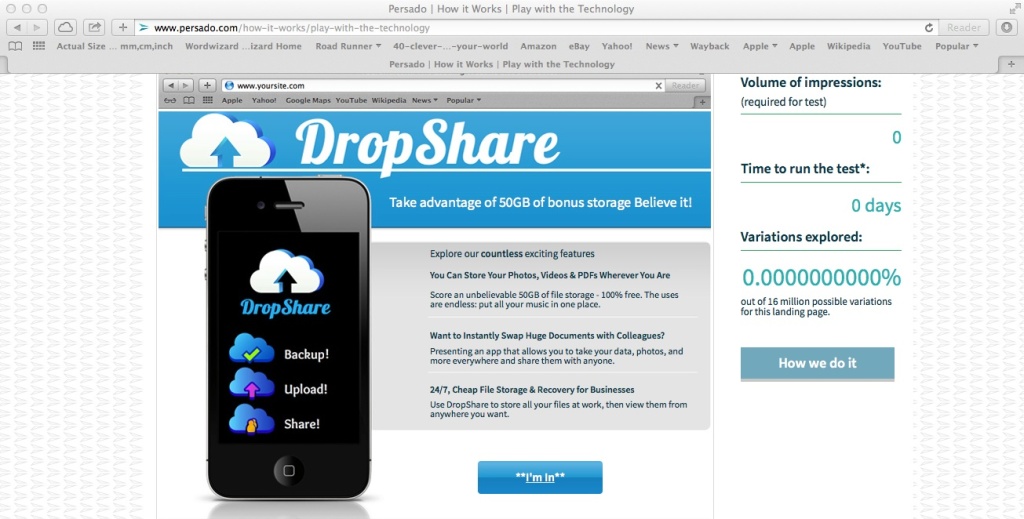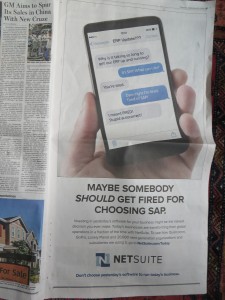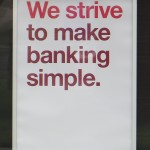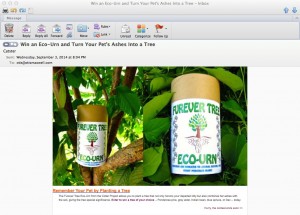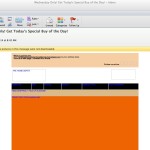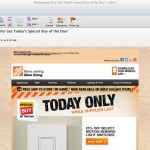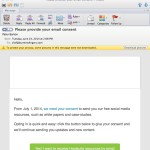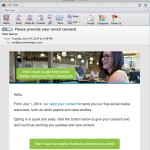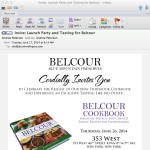We Boomers have a bug up our rear for Millennials, much as the “Greatest Generation” probably felt about us back in the day. Wall Street Journal reported on how they don’t like to use the telephone (probably because it intrudes too much on their personal space), and there’s now an app that allows them to hire household help without the awkwardness of meeting face to face and giving instructions.
In short, Millennials are self absorbed. Just look at them: walking with their heads down, obsessed with their iPhones, as they board their Google buses with the dark windows that will swoop them up to earn big bucks at whatever it they do. Goddam kids…
I have noticed a consequence of this in what I’ll call Mumblecore Marketing: emails that are deliberately casual and slouching, as if it’s almost too much trouble to get around to selling you something. As a side benefit these emails seem like they were written by somebody you know, though you can’t remember exactly how you know them.
Nicole Marshall of DMNews—by definition a direct marketing best practitioner and careful tester—is a great mumblecore marketer as far as subject lines go. “Did you see this email” “Re: 2 weeks left” “Are you free at 1 PM ET?” and “Log in now!” are a few that made me look. The body content is fairly straightforward, but the casual subject lines get my attention which is what they’re supposed to do.
Peter Coates of insideout.com starts with the subject line “Following up” and begins,
Hi Otis,
I sent you an email the other day… if your inbox looks like mine, you may have missed it. Just wanted to let you know Inside Out is holding a Performance Coaching workshop at the Fremont Marriott Silicon Valley on March 11.
It’s designed to help more leaders coach more often, for more business impact. Would you or your colleagues like to attend the training? There are a couple of discounts available if you are in a position to evaluate for your company or if you would like to bring your colleagues with you.
I’m happy to set up a call. Let me know a few times this week when you are available for a conversation.
Warm regards,
Peter
This is a very hard sell situation—a paid seminar—but the casual tone is disarming. Mentioning a previous email I didn’t read—a classic direct response no-no—makes it fresh and personal. And referring to “a couple of discounts” without getting into the details of pricing raises curiosity rather than objections. Once I get this far, there’s more straightforward content (including the price) below his signature.
Mumblecore, as you no doubt know, has its roots in independent film, usually low budget and featuring actors who try to appear non professional in order to create a realistic, slice-of-life storyline (though often there isn’t a storyline) including Greta Gerwig taking off her clothes. The term was coined by a sound editor, who was probably frustrated that he could not always understand what the actors were saying.
In mumblecore movies and in mumblecore marketing, the illusion of authenticity is absolutely essential. Make one false step and you turn yourself into a laughingstock. Such was the case with this email, which arrived with the subject line: “Young entrepreneurs… disrupting the food industry – Fancy Food Show 2014”.
Otis-
My name is Blake & I’m the Founder at eatKeenwa. We’re a bunch of mid-to-late 20 year old entrepreneurs disrupting the status quo in the food industry and re-pioneering American manufacturing. We’re doing something different for once.
We make a stellar snack out of quinoa. It’s robust in flavor, full of functional benefits and packaged with commanding presence.
Please stop by our booth, #5126. I would love to share our story with you. It will leave you engaged and will resonate with your audience.
Please check us out at www.eatkeenwa.com.
Thanks & Be Well,
Blake Niemann
The casual tone is there, but it’s disrupted by jargon and hype: “resonate” “engaged” and “commanding presence” are meaningless and overused and instantly tip off the reader. Kudos, though, for inventing a new word, “re-pioneering”. That truly is “doing something different for once”.
I hear often from Peter and Nicole, suggesting their marketing works; Blake was a one-shot wonder. I have the feeling the mumblecore marketing for eatkeenwa was suggested by a consultant, probably an elderly wretch with tobacco-stained fingers, who then couldn’t resist adding a few time-tested zingers. Blake, if you’re reading, try writing your own copy next time. After all, you and your fellow rambunctious twentysomethings are the real deal.
